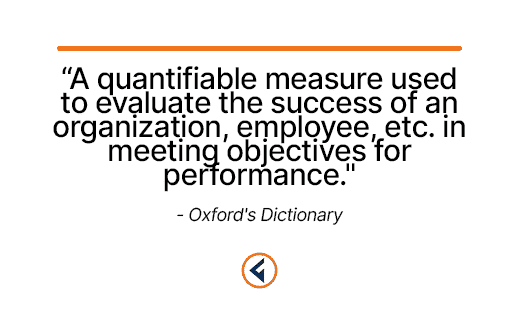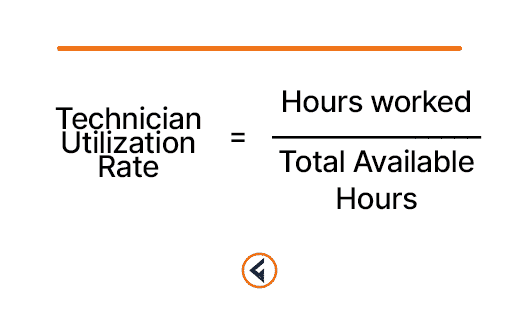Leaders in the field service industry are always using KPIs and metrics to make the best possible business decisions. For example: deciding when to hire additional help, when to increase pricing, whom to send to a specific job, and investment opportunities in field service management software.
Data will be king in 2022, as more industry leaders turn to big data to guide their decisions and move their companies in a growing direction. Managers and executives can use KPIs to improve every aspect of the field service business, including dispatching, parts requisitions, and even estimating for projects.
Let’s look into what KPIs people are tracking and why they are essential for continued success.


How to pick the correct KPIs for your business
Deciding what KPIs your business can track can be one of the most challenging decisions, especially if you don’t have field service software with Business Intelligence, analytics, and reporting capabilities to turn that data into useful KPI reports.
Data means different things to different people: that is what makes it so challenging. For example, not all managers, technicians, and executives need the same data to do their job and make better decisions. Furthermore, some use the same data points but look at them through an entirely different lens.
What are Your Business Goals for Your KPIs?
To select the correct KPIs, you must first decide what business goals you want to accomplish. For example, is the goal of the KPI to increase the number of service calls your team can take in a day? That would require KPIs around travel times and mean time to repair. On the other hand, do you want to enhance your customer experience and make your customers happy? Then you might track first-time fix rates, average response times, and customer churn rates.
Can You Take Action to Achieve the Goals?
Next, your KPIs need to be actionable. Tracking KPIs is great, but if you don’t have the means to act on them and improve your business, it’s not useful data. That’s why not all data is essential for delivering on your business goals. You also need to make sure your goals are actionable and aren’t out of your control. For example, tracking a KPI based on how many days you couldn’t work because of bad weather may seem like a great goal. However, you can’t take action because you can’t control the weather.
Do You Have Access to the Data?
The amount of data you can turn into useful KPIs are endless. This will drive your decisions through complex data, rather than making gut feelings. You also need to have access to information, which can be hard to come by if you don’t have systems in place to collect and analyze data. Organizations that are still operating manually or through spreadsheets have to perform calculations by hand. That is timely and requires someone to complete the task which can result in errors and delays.
It is hard to make a meaningful change if you don’t act upon it early enough. If not, bad habits settle in, and KPIs can’t be worked on. That is why analytic tools in Business Intelligence are helpful, as they take real-time data from the field and turn it into KPI reports that businesses need at any moment.
The Field Service KPIs to Track in 2022
Field service is complex, and as mentioned, different people, departments, and parts of the business require different KPIs and metrics. Let’s look at the most common KPIs and metrics different stakeholders need to be tracking in 2022.
KPIs for dispatchers
Getting the right people, with the right skills, to the right job is a constant struggle for dispatchers in any field service business. Dispatchers are the people who keep the operation running smoothly, scheduling technicians and dispatching them to their respective jobs. It’s tough to manage a large influx of calls that can throw off a perfectly timed schedule, requiring some fast thinking to route technicians to the new job.
Delays can lower productivity and upset customers. For example, 67% of customers said they would never rehire a field service company again if they were over an hour late.
Here are some of the common KPIs and metrics that concern dispatchers.

Time to Schedule
Getting jobs scheduled quickly is always the primary goal of any good dispatcher, especially when contracts are in place, and written agreements exist between the business and the customer to meet scheduling targets. For example, a customer with a specific level contract will have a repair scheduled within 24 hours of calling in.
With an influx of jobs coming, dispatchers have to think about getting them into technicians’ calendars quickly to avoid delays. A delay in getting jobs scheduled can lead to lower productivity and longer downtimes for technicians in the field. By focusing on this area and making it a KPI for your dispatchers, you can have less technician downtime, reduce the risk of customers having to wait for service, and keep work orders from piling up.
Time to First Contact
The first impression might be the most critical. When customers call and ask for service, they don’t know what to expect from your business. That means you can deliver a great impression, and they will continue to use your service in the future. But, unfortunately, it also means you can provide lousy service, and they won’t use you again. Or worse, call and cancel and find someone else.
In 2022, make time to first contact a KPI for your dispatchers to ensure that when new customers call, they get priority to be seen and not left waiting. By seeing how long it takes for new customers to be scheduled, you can identify if this is a problem area for your business. For example, are you losing potential customers because it took days to get someone to their location?
It’s also a time to test out different first contact methods, such as text messaging details about the technician’s arrival time or booked appointment confirmations. Automate communication with the customer so that they know the technician is scheduled and will be on their way.
Travel Time
Dispatchers need to know how long it takes technicians to get to job sites and how long they are driving. Travel time between jobs is a KPI to focus on in 2022 for two primary reasons.
First, the more time technicians spend driving, the less time they are working and billing hours. This could be for multiple reasons, such as poor route planning or work order distribution. Sometimes dispatchers and technicians can’t avoid high travel times, but by looking at ways to reduce travel time, dispatchers will successfully book more service calls.
Second, expenses with more travel eat away at the bottom line. For example, the more traveling a technician does, the more gas they use and the more mileage they put on their vehicles. These expenses can quickly chip away at profit growth and even get service vehicles taken off the road more frequently for repairs due to the hours of logging time on the road.
A high travel time might also signify that you are booking calls too far away from your business location. This could mean you need to lower your service area or you need to hire more technicians to cover more ground. This is especially important in jobs requiring specific skill sets. You don’t want your specialty technicians having to drive greater distances.
It might also mean you are taking on too many last-minute bookings and trying too hard to get them into a schedule without thinking of the route the technician being scheduled will have to take or their location to that service call.
KPIs for Field Service Managers
Keeping the business moving is the job of a dispatcher. Keeping the business growing and scaling is the job of the field service managers. Field service managers are looking at ways to increase performance from the business and drive revenue. Many field service managers care about the customer experience and design KPIs around keeping their customers happy. That’s because happy customers are return customers, and less churn means more profit.
Field service managers oversee the operation and try to get the most out of the people in control of dispatching, sales, customer relationships, and brand value.
Here are some common KPIs and metrics that concern the managers in a field service business.

Technician Utilization Rate
Getting the most out of your technicians will be a critical KPI for 2022. With a worker shortage in the field service industry, many field service businesses have to do more with less. To see how well you use your technicians, you need to calculate their utilization rate.
That means taking their working hours and seeing how much of that time is being used on actual work or ‘wrench time,’ and how much is being used on other tasks such as driving and administrative work, or even meetings.

This KPI doesn’t necessarily mean your technician isn’t working hard enough. But instead, they may not have processes or technology to get jobs done quickly. For example, they could be spending 30 minutes per appointment completing paperwork and checklists that need to be submitted to the office. If those are being completed on paper, it will require more time than if they were filling in answers on their mobile device when working.
Managers want to see where they are losing time as a business to make proper adjustments and investments to help their technicians succeed in the field.
Variance from Standard Repair Time
For field service businesses with experience and plenty of knowledge about how long it takes to complete a job, the variance from standard repair time KPI is something to track in 2022.
If you are already collecting data on how long each service call takes, look at going a step further and compare it to other service calls of the same nature. Keeping track of variance from standard repair time can give you insight into the changing nature of the job, provide insight on operational issues, or have you reconsider the people you are sending to these calls.
For example, if you notice junior-level technicians take twice as long to complete appointments, they may need more training or supervision. By tracking this KPI, you can also set consistent fix rate targets, and dispatchers will be better equipped when scheduling, having a consistent idea of how long specific calls will take.

First-Time Fix Rate
Some KPIs just never go out of style, and the first-time fix rate continues to be a KPI every field service business needs to track.
How often your technicians fix a problem on the first visit can be a significant indicator of things going well or wrong in your business. For example, a low first-time fix rate could mean a lack of experience in technicians being sent to the job. But, on the other hand, it could also mean they aren’t going with the right parts, incomplete diagnosis, or simply are the wrong technician for the job that requires more skills.
First-time fix rate can open a large door into the entire business’s ability to perform service. Leading field service companies want a first-time fix rate above 85%. That requires properly diagnosing problems, allocating the right resources and parts, and making sure the right technician is on the job.
If any single KPI is important, it might be first-time fix rate, as a high rate will mean higher customer satisfaction, technician utilization, and confidence in dispatchers.
KPIs for Technicians and Subcontractors
Smart field service businesses have KPIs from top to bottom, and some of the most essential KPIs deal directly with the people in the field. Technicians and subcontractors should have their own KPIs to try and hit each month so they can be rewarded with bonuses or increased wages.
What these metrics help identity, however, is the behavior of your technicians in the field. It’s a way for managers and executives to identify who their best technicians are, whom they can trust with subcontractor work, and who needs more job training to make them valuable team members.
Field service businesses are only as strong as their technicians make them, so it’s crucial to track KPIs at the technician level to empower decisions around the scheduling, dispatching, and job assignments for these workers.
Mean Time to Complete
There are a few mean times to consider, such as mean time to service and mean time to repair. But for 2022, the mean time to complete might be the better one to track, as it can incorporate all of the above.
For example, the mean time to complete a call can include:
- The time it takes a call center agent to take information
- How long it takes a dispatcher to schedule the call
- The driving time to get to the appointment for the technician
- Repair time from arrival to finish
- The administration time to complete the work order and to invoice
There are plenty of hands involved in an appointment, and anyone can slow down the process. Find the clog and remove it to free up more time for service appointments.
Attachment Rate
Attachment rate may be one of the newest KPIs to track for field technicians because it requires them to become part of the sales team. The attachment rate is how often they upsell customers, either for contracts, higher quality parts, or for more service time to fix additional problems they noticed while on-site.
Technicians are being asked to come with more soft skills such as sales training and customer service in order to generate more revenue. Since they have access to the equipment needing repair and expertise in the field, customers are more likely to listen to their recommendations for service and parts.
A low attachment rate could mean poor sales training or the technician is lacking the motivation to upsell. On the other hand, the technician could simply be unprepared to make the sale or add additional services. There is also a fine line in upselling a customer during an interaction when they weren’t ready to be upsold.
Customers may also not be seeing the value in your service. Following up with a sales team member can be worth it, especially after appointments with a technician with a low attachment rate to see if they can engage the customer in a higher plan.
Ready to Set High KPIs and Metrics?
Choosing the correct KPIs for your business can set you up for success in the future. However, you need to be able to capture data and track the progress of KPIs throughout the year, often in real-time.
That requires a form of field service software, mobile field service applications, and Business Intelligence to facilitate the collection and calculation of all the data and metrics coming in, then turn those metrics into valuable reports, dashboards, and KPIs.
Relying on manual operations and not automating KPI reporting will have you behind from the beginning. It also will limit who will get KPIs, how many they can track, and how useful they will be. Using an automated Business Intelligence tool in field service software will allow each person to build KPIs and essential reports, whether a technician, dispatcher, manager, or executive.
From these reports, the team can start to take action and make better business decisions based on data to better the business.

